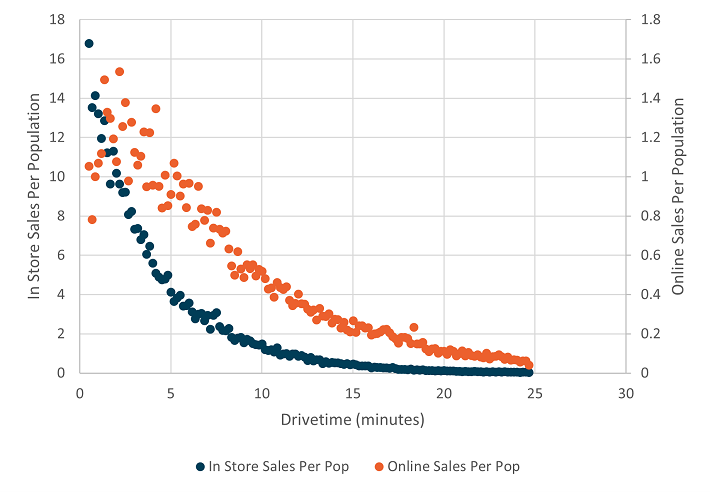What causes the online halo?
As much as the precise cause of the classic halo is not entirely settled, the online halo is not totally understood by retail planners. Yet their importance when planning and forecasting, means we need to both understand and model them when planning multi-channel networks.

The classic halo, more properly the 22°halo, is an area of darker sky surrounded by a narrow band of brightness. In retail an ‘online halo’ has come to mean a generic increase in online sales coming from areas closer to a store; it should really be called the online glory. The precise cause of the 22° halo is still problematic and not entirely settled. It is certainly something involving ice crystals and refraction. The cause of retail online halos similarly does not have a single simple explanation.
Online halos are important when planning fulfilment centres, returns, in-store sales forecasts, and ranging. They display different patterns and arise in multiple ways, for example:
- A typical decay curve with hubs (either stores or dark stores) acting as the halo origin
- An inverse relationship with sales depressed near stores or restaurants
For retail planners, whilst we do not have a universal explanation, they are important and need to be modelled as we plan our multi-channel networks.
The mechanisms for how such patterns arise are critical to predicting the way they will manifest.

“In our explorations of online/offline sales patterns using customer data across hundreds of projects and dozens of sectors there are seven main causal pathways”
- Range familiarity. You know you like Sainsbury’s own brand ketchup or that the Reiss sizing fits you. You know this because you shop there offline, and as people are more likely to shop near where they live the online sales form a halo.
- Billboarding. When you walk past a large dynamic exciting living poster every day (a well-dressed shop) that brand is likely to be top of mind when it comes to purchasing online. Awareness driven halos emerge.
- Retailer Customer Relationships. When a retailer has your details and knows what you like as an offline customer, they are clearly able to talk to you, craft offers and suggest delivery slots you will like. The very presence of a relationship will drive online halo.
- Demographic Brand Fit. Waitrose stores are more likely to be sited in affluent small towns. People who live in affluent small towns like Waitrose so order online from them. Sales are therefore higher closer to Waitrose stores, this is often mistaken for a true online halo.
- ‘Delivery’ Cost. With the likes of Deliveroo this is obvious and revealed at order time, for pizza delivery it is manifested in colder less appetising pizza at the end of a long trip. The cost of delivery discourages long trips and so a halo is formed.
- Slot availability. When you shop online, particularly for food, the number and price of delivery slots is tailored to your address. Food delivery companies would prefer to send a van 1 mile rather than 10. The cheap deep availability of slots close to fulfilment centres (often stores) drives uptake and so we see halos.
- Walk-in doughnuts. When a store is a very short walk away the appeal of online delivery can fade. Where collection is a viable option the appeal and promotion of online ordering and walk to collection can be strong (click and collect). An inverse halo within a few minutes walk can often be seen.
Whilst numbers 1 to 3 are what we may describe a ‘true’ online halo, the others are ones that can be mistaken as being.
Thinking through this range of causal pathways it is clear there cannot be a simple single formula for what an online halo is. What it is worth, how it should be predicted are all situational and will depend on the brand, the sector, the competition, the retail context, and also individual shop locations and customers preferences. If you would like to discuss how to forecast online halos please do get in touch.
Blair Freebairn, Chief Executive at Geolytix
Photo by Miha Rekar on Unsplash
